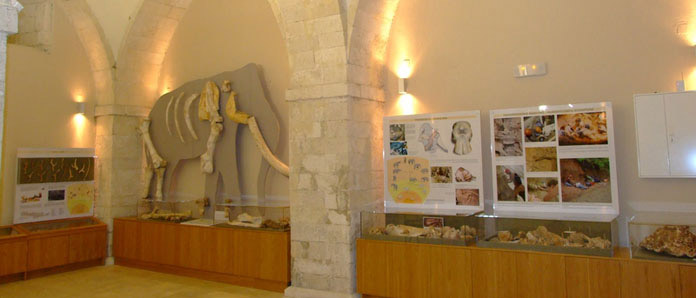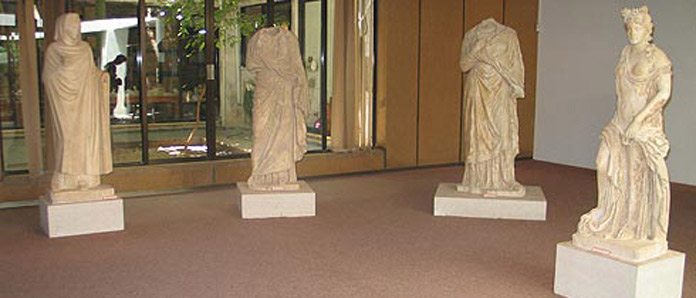Rethymnon  Museums & Monuments in Rethymnon
Museums & Monuments in Rethymnon
If you visit the Archaeological Museum of Rethymnon you will have the opportunity to see some of these findings and have an image of the cultural history of the Prefecture, from Neolithic Age until Roman Period. The findings are exhibited in chronological unities and in excavation order. The collections include findings form caves, settlements and cemeteries of the Minoan Period, but also objects from the Geometrical, Archaic, Classical, Hellenistic and Roman Period, brought to light by the archaeologists, during the excavations in ancient towns. You should not miss the serrated helmet and the urns from the Late Minoan cemetery of Armeni, the sculpture of Aphrodite from Argyroupolis, the seals as well as the collections of golden jewellery and coins.
Before entering the Museum, it’s worthwhile observing the place where it is housed. The building in question has been characterized as a historic scheduled monument under ministerial decision and it is a Venetian building dating back to the 17th century. The main characteristics of the building are the stone stairs, the room with two series of Venetian windows as well as the kitchen with the chimney. Entering the Museum, you’ll see beautiful collections of traditional handicrafts and weavings, basketry, ceramics, historical relics, documents, photographs, banners, maps, weapons and coins. There is also a special room dedicated to traditional grain farming and the way of preparing traditional bread in Rethymnon, while in an other room traditional professions are presented (coppersmith, saddle-maker, farrier, etc). Don’t forget to ask about temporary exhibitions presented in the Museum on a regular basis.
Going to Rethymnon and not visiting the Fortezza it is like going to Paris and not seeing the Eiffel Tower. The reason is simple: this Venetian fortress constitutes until today a trademark for the picturesque town of Rethymnon and during the last 18 years the Erofili Theatre accommodates, dancing, music, theatre performances, but also exhibitions of paintings, speeches and cinema. The Venetian fortress is built on the hill of Paleokastro, in the west side of the modern town. On this hill you can see the fortification of the ancient town of Rithimna and the temple of Rokkaia Artemis. During the following centuries, the town of Rethymnon was grown in the same place. After the Turkish incursion in 1571 and the destruction of the ancient town, there was an urgent need for fortifications, since the already existing walls did not offer complete protection. Fortezza was founded in 1573 on the hill of Paleokastro.
The initial aim of its construction was to comprise all the houses of the town, plan that finally did not come true. After the elimination of the Turkish danger, the inhabitants of the town started rebuilding their houses. Works in the area of Fortezza were completed in about the year 1580. Only Venetian garrison was installed in the fortress, since the free space left for the construction of private houses, after the completion of public buildings, was finally too small. After 1646 and the Turkish occupation, the Fortezza will not suffer important changes. There were extensions and making ups to the banking up and the surrounding wall of the fortress. However, the number of the houses built inside the fortress was increased. At the beginning of the 20th century, the interior of the Fortezza was almost completely built. The inhabitants gradually began to move outside of the fortress and the Municipality of Rethymnon undertook the demolition of dilapidated buildings. Meanwhile, the Municipality, the Archaeological Service and the Greek National Tourism Organisation expropriated those lands. Nowadays, besides the cultural activities of the Municipality, in Fortezza you have also the chance to enjoy the panoramic view of the town of Rethymnon and the deep blue sea.
Τhe Holy Monastery of ArkadiΑt is located at an altitude of 500 m and 23 km away from Rethymnon, in a place of historical interest , which became the symbol of self-sacrifice and freedom during the revolution of 1866-1869. Rather than surrendering to the Turks, the besieged locals in the Monastery decided to sacrifice themselves. Kostis Yamboudakis was the brave man who set in fire the ammunition room where all besieged had gathered and then blew up the Monastery. The sacred banner of the revolution as well as monastery utensils, gold embroidered vestments and weapons are exhibited in the Monastery Museum. You will be impressed by the facade of the church with its elaborate capitals.












